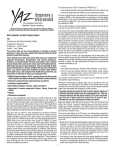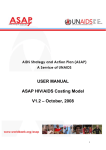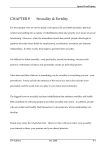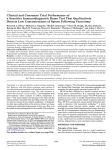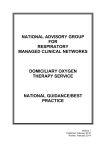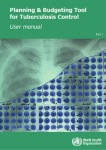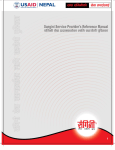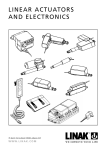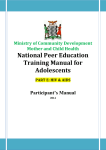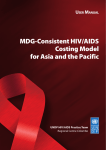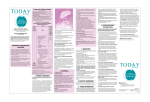Download Module 7
Transcript
Module 7 Family Planning and Contraceptive Methods SRH Facilitators’ Training Manual: Module 7 Family Planning and Contraceptive Methods SRH Facilitators’ Training Manual: Module 7 Family Planning and Contraceptive Methods Table of Contents Introduction Introduction1 Chapter 1: Family Planning2 1.1 Family Planning2 1.2 Accessibility of and Referral for Contraceptives 3 Referral4 Chapter 2: Contraceptive Methods5 2.1 Barrier methods5 2.1.1 Male condoms Male involvement in contraception and family planning 5 2.1.2 Female condoms15 2.1.3 Diaphragm/cervical cap18 2.1.4 Spermicides19 2.2 Intrauterine methods20 2.2.1 Intrauterine device (IUD)20 2.3 Hormonal methods21 2.3.1 Oral contraceptives (The pill)21 2.3.2 Injectables25 2.3.3 Implants26 2.3.4 Birth control patch (Contraceptive patch)26 2.3.5 Emergency Contraception 27 2.4 Permanent methods27 2.4.1 Tubal ligation (female sterilization)27 2.4.2 Vasectomy (male sterilization)28 2.5 Natural methods28 2.5.1 Abstinence28 2.5.2 Lactational Amenorrhea Method (LAM) (prolonged breast-feeding) 28 2.5.3 Cervical Mucus Method28 2.5.4 Basal Body Temperature29 2.6 Traditional methods29 Annex - Tools and master copies for Module 7 © Deutsche Stiftung Weltbevoelkerung This module is on Family planning and contraceptive methods. It is divided into two chapters; chapter one focuses on Family planning and goes ahead to explain family planning and benefits of family planning to the children, family, men and women, and the large community. The chapter also gives information about accessibility of family planning and referral service in accessing family planning services. Chapter two focuses on contraceptive methods and how to use them. The chapter also gives advantages and disadvantages of each contraceptive method. This chapter finally addresses male involvement. The facilitation of this module with all its exercises is expected to take about 7 hours. Learning objectives By the end of this module, participants will be able to: • Understand the concept of family planning and benefits for the family and the community • Describe usage, advantages and disadvantages of different contraceptive methods • Discuss upon the most useful contraceptive methods in different situations 33 © Deutsche Stiftung Weltbevoelkerung 1 2 SRH Facilitators’ Training Manual: Module 7 Family Planning and Contraceptive Methods SRH Facilitators’ Training Manual: Module 7 Family Planning and Contraceptive Methods Chapter 1: Family Planning 1.1 Family Planning Family planning is the voluntary use of different appropriate methods to anticipate and attain their desired number of children and the spacing and timing of their births. But it involves a lot more than using contraceptives: The decision to have sex Young adolescents and young people make a decision when to have sex. This decision lies entirely with the individual. The decision to have sex can also be looked at as being one aspect of family planning – no sex, no family. Young people have a right to decide when to have sex, however, the longer they delay having sex, the better is the position they find themselves in to make informed decisions and successfully plan their family. The decision to have children Many young adolescents and young people believe that it is a must to have children when living in a relationship. This is not true, because the decision to become pregnant and give birth is at the discretion of a couple, and both partners should be in agreement that they want children. Young adolescents and young people, especially boys, are not supposed to push for sex and pregnancy because girls as well have a decision to make; whether that is what they want or not. Family size and frequency of child bearing It is the sole responsibility of the couple to decide how many children they want to have and how big they want their family to be. It is not the responsibility or right of the man or the woman alone to decide how many children the family should have. Neither is it the right of the man alone to decide how often his wife will be pregnant. They have to decide together and it is the right of women to resist any forced pregnancies and child bearing. The decision to use contraceptives The use of contraceptive is a right of women as it is a right of men. Men should not only support their partners in matters related to contraception, they should in fact participate actively in family planning. To the whole FAMILY • Freedom to decide when to have children • Less emotional and financial strain • Increased educational opportunities • Increased economic opportunities • More energy for household activities • More energy for personal development and community activities To WOMEN and MEN • Better health • Less physical/emotional strain • Improved quality of life • Increased educational opportunities • Increased economic opportunities • More energy for household activities • More energy for personal development and community activities To the COMMUNITY • Reduced strain on environmental resources (land, food, water) • Reduced strain on community resources (health care, education) • Greater participation by individuals in community affairs 1.2 Accessibility of and referral for contraceptives Accessibility Contraceptives are widely available in most health facilities (including hospitals, health centres, clinics, pharmacies and drug shops) and from sexual and reproductive health or family planning organizations. Even in non-medical enterprises, one can find contraceptives (e.g. condoms). Most government aided health facilities and sexual and reproductive health organizations provide contraceptives and information on their use free of charge. The benefits of family planning To the CHILDREN • Better health • More food and other resources available • Greater opportunity for emotional support from parents • Better opportunity for education Contraceptives can be bought in commercial enterprises such as private clinics, drug shops, pharmacies and shops (condoms). Where someone cannot afford contraceptives, it is possible to visit a government-supported health facility where contraceptives are available free of charge. The prices differ for different contraceptives. The condom and pill are the cheapest and tubal ligation and vasectomy are the most expensive ones, as they involve surgery. Which particular contraceptive to use is a decision everyone will take individually. To choose which contraceptive works best for you, you need to know the advantages, disadvantages and proper use of the various available methods. You are therefore strongly advised to contact a qualified family planning service provider, a health care professional or counsellor before using any type of contraceptive. © Deutsche Stiftung Weltbevoelkerung © Deutsche Stiftung Weltbevoelkerung 3 4 SRH Facilitators’ Training Manual: Module 7 Family Planning and Contraceptive Methods SRH Facilitators’ Training Manual: Module 7 Family Planning and Contraceptive Methods Chapter 2: Contraceptive Methods Referral When you are a Peer Educator or counselling young adolescents and young people on which contraceptives to use, remember to consider their individual situation. It is important whether the individual is sexually active, has a permanent partner, is pregnant or not, and or whether he/she is HIV positive. For example, some contraceptives such as spermicides and diaphragm are not recommended for STI-infected persons, as they can increase the danger of re-infection, of contracting another or worsening an existing STI, and provide no protection for the partner. This is why referral to qualified health care providers is important. Refer your clients to a health facility you know, and be sure to have evaluated and proved that this facility offers youth friendly services. Young adolescents and young people need youth-friendly services that provide for privacy, respect and equal treatment instead of being blamed. After referral, follow up with both the individual and the health facility to establish whether your client actually received a satisfactory and youth-friendly service. Basic Information A contraceptive is a drug or device used to prevent pregnancy. There are many contraceptive methods, but only the condom can prevent both prevent pregnancy and STI’s. This Module 7 focuses on pregnancy prevention. For more detailed information on STI’s, please refer to Module 6. Most contraceptive methods are reversible; that means that a woman will be able to become pregnant again after she has stopped using the method. Some methods including male and female surgical sterilization are permanent, which means that the decision is final. A man who has undergone a vasectomy will never impregnate a woman, and a woman who has had a tubal ligation will never get pregnant. This Module 7 introduces a range of contraceptive methods. Even though not all of the methods introduced may be recommended for young adolescents and young people or available where you are, it is important to know them and understand how they work. Contraceptive methods are frequently referred to by the way they prevent pregnancy. There are: • Barrier methods • Intrauterine methods • Hormonal methods • Surgical (permanent) methods • Natural methods • Emergency contraception • Traditional methods 2.1 Barrier methods 2.1.1 Male Condoms A male condom is a thin rubber sheath made of latex. It is placed on the erect penis before sexual intercourse to protect against unwanted pregnancy and STI’s including HIV and AIDS. Condoms come with different features: they can be smooth, ribbed, studded, lubricated, flavoured, coloured etc. They should be used only once and then properly disposed off. How it works It works by preventing a man’s semen from entering a woman’s vagina, thus preventing the sperm and ovum from uniting and avoiding conception. How to use a male condom 1. Always put on a condom on once the penis is erect and before any contact is made with your partner. Make sure to a. buy condoms from a reliable source and b. check if the condom is still okay by checking the expiry date and pressing the wrapper to check if it is sealed and also feel if pressure is still there. © Deutsche Stiftung Weltbevoelkerung © Deutsche Stiftung Weltbevoelkerung 5 6 SRH Facilitators’ Training Manual: Module 7 Family Planning and Contraceptive Methods SRH Facilitators’ Training Manual: Module 7 Family Planning and Contraceptive Methods 2. Carefully open the package so as not to damage the condom. Don’t use nails or teeth. 3. Penis should be erect (hard) before putting on the condom. 4. Squeeze the tip of the condom and put on the head of the penis (squeezing the tip allows for semen to collect and reduces the possibility of bursting). 5. While still holding the tip, unroll the condom down to the base of the penis. (Do not put on a condom after it has been unrolled, for it may tear in the process). 6. Then one is ready for intercourse. 7. After ejaculation (coming), hold the base (ring) of the condom and withdraw (pull out) the penis from your partner before the penis gets soft (holding the rim keeps the condom from slipping off). 8. Slide the condom off the penis without spilling the semen. (If possible one should use tissue paper, towel, or anything available when unrolling the condom). 9. If paper is available, wrap the condom in it and throw it in a pit latrine or bury it (condoms must only be used once). 10. Wash hands with soap and water. Advantages: • Condoms are 97% effective and they protect against most STI’s if used correctly and consistently • Condoms are the only contraceptives that can prevent STI’s including HIV and AIDS and pregnancy at the same time • Condoms are inexpensive and easy to get • Condoms are lightweight and disposable • Condoms do not require a prescription • Condoms can help relieve premature ejaculation • Condoms may help a man stay erect longer • Condoms can be put on as part of sex play • Condoms can be used with other methods Disadvantages Some men and women feel that the condom dulls sensation. Others become frustrated and lose some of their sexual excitement when they stop sexual engagement to put on a condom. Some men are self conscious about using condoms. They feel pressured about having to maintain an erection to keep the condom on. Others feel pressured to ejaculate. Many overcome these pressures and learn to enjoy using condoms by using them during sex play before intercourse. Side effects Condoms have no side effects except for people who are allergic to latex. Some women and men have such allergies. They may use plastic male or female condoms instead. Effectiveness A condom is extremely effective when used correctly. The effectiveness is increased when used with spermicides. © Deutsche Stiftung Weltbevoelkerung © Deutsche Stiftung Weltbevoelkerung 7 8 SRH Facilitators’ Training Manual: Module 7 Family Planning and Contraceptive Methods Remember to… SRH Facilitators’ Training Manual: Module 7 Family Planning and Contraceptive Methods More tips about condoms: • Correct and consistent use of condoms protects you and your partner from STI’s and pregnancy • Using condoms is a responsible act that shows your concern for your own and your partners health • Many married couples use condoms. They are not only for sex outside marriage • Most people who use condoms do not have HIV and are healthy • Proposing condom use does not mean a person is infected with HIV. It means that the person is responsible and caring. It does not imply mistrust • Condoms are high quality and do not have holes • Condoms do not contain or spread HIV • Nearly everyone can use male condoms, regardless of penis size • Using condoms may change the sensation of sex, but sex is still enjoyable. Some couple find sex even more enjoyable with condoms • Male condoms do not make men sterile, impotent or weak and do not decrease their sex drive Use correctly EVERY TIME For full protection, you need to use a condom EVERY TIME you have vaginal or anal sex. Use a condom every time to avoid infecting yourself or your partner. If you cannot use a condom every time, another method of family planning can prevent pregnancy but not infection. Keep plenty on hand Get more condoms before you run out. Consider emergency contraception. (See page 33) Use an emergency contraceptive pill if condom breaks or slips. Condoms rarely break if properly used. If condoms break often, make sure they are not damaged or old. Review instructions for proper use. Also, try lubricated condoms, or use water or water-based lubricant on outside of the condom. Do not use a condom if the unopened package is torn or leaking, or the condom is dried out. Water-based lubricants only No oil-based lubricants! Use only water-based lubricants, such as glycerine based, certain commercial lubricants, clean water, and saliva. Oils weaken condoms so condoms can break. Do not use oil-based materials such as cooking oil, baby oil, coconut oil, petroleum jelly, butter. Check whether the condom you are about to use is lubricated or not. Sunlight and heat can make condoms weak and they can break. Adapted from: Reproductive Choices for PLWHA, WHO, 2006, slide 22 © Deutsche Stiftung Weltbevoelkerung Exercise 1: Step by step demonstration and practice on the correct use of a male condom Objective: To enable each participant to use a condom correctly and safely Method: Demonstration and exercises Tools: Penis model, banana or bottles, cards with single steps from page 10, condoms Time: 60 minutes Facilitators’ tasks: 1. 2. 3. 4. 5. 6. 7. 8. Prepare in advance the step-by-step instruction on page 10. The sheets contain both illustrations and words describing the steps. Carefully photocopy the 5 steps of using a condom on cards or paper. (See annex for master copies). Using a penis model and a condom, demonstrate how to properly remove a condom from the package and place it on the model, following the steps described below. Show the steps to follow when putting on a condom (about 5 minutes). After the demonstration and a brief discussion, distribute penis models (you can also use bananas or bottles) and condoms, every the participant should put a condom on a model at least once. Ask the participants to practice putting on and removing a condom using a penis model and a condom (10 minutes). Summarize the main steps and ask for feedback from the participants. Can the exercise help master the use of a male condom? What are the problems? Select five volunteers from the group of participants. In random order, distribute the prepared “How to use a condom” cards to the volunteers. Instruct volunteers to look at each other’s cards and line up in correct order across the room (about 7 minutes). © Deutsche Stiftung Weltbevoelkerung 9 10 SRH Facilitators’ Training Manual: Module 7 Family Planning and Contraceptive Methods 9. Instruct the group to observe the problem solving skills used by members of the “card” group while completing the exercise. 10. After the participants with their cards are in the correct order, ask each volunteer to describe his/her card. Discuss any questions or comments participants may have (about 15 minutes). 11. Summarize the lessons learned and ask for feedback from the participants. What are the problems faced in performing the exercise? Can Peer Learning Groups use this exercise? Myths and Misconceptions on condom use: • Condoms break a lot and are not reliable • Condoms fall off and get lost in the vagina • Condoms are expensive • There are defective condoms • It is embarrassing to get condoms • I do not have knowledge and skill in using a condom • Condoms make peers more promiscuous • I can’t feel anything when I wear a condom; it diminishes pleasure • None of my other friends use condoms • It is embarrassing to be seen with a condom Exercise 2: SRH Facilitators’ Training Manual: Module 7 Family Planning and Contraceptive Methods Exercise 3: Life skills to overcome barriers to condom use Objective: To enable participants to identify life skills to overcome barriers in using a condom Method: Exercises Tools: Flip chart, paper, pens, markers Time: 35 minutes Facilitators’ tasks: 1. Ask participants to form four small groups. Use a group-dividing technique. 2. Assign to each group one of the four most prominent barriers identified and ranked earlier. 3. Ask the groups to identify and list the kind of life skills necessary to overcome the barriers to the use of a condom. Different life skills may apply to different behaviours. (See example below). 4. Allow 10 minutes for small group work. 5. When the time is up, let the groups come back. 6. Ask a presenter to brainstorm on the life skills identified. 7. Write on a flip chart the life skills mentioned (under the four barriers). 8. Summarize the main life skills learned for overcoming the barriers and ask for feedback. Was the exercise helpful? Identifying mental barriers in using condoms Objective: Participants will be able to identify barriers in using condoms Method: Large group discussions Tools: Buzzing, brainstorming Time: 25 minutes Facilitator’s tasks: 1. Ask participants to form buzz groups of 2 or 3 with their neighbours. 2. Ask them to briefly discuss and list 4 misconceptions, negative attitudes and behaviours towards the use of condoms (5–7 minutes). 3. Ask them to rank the barriers. 4. Ask one of the buzz group members to share the first two issues from the list with the whole group and brainstorm on them. (See example below) 5. Record the statements on a flip chart without comments. 6. Then screen and merge repeats and compare with the facts in the handout. 7. Rank the barriers in order of their potential to prevent a person from using a condom. 8. Summarize the important attitudinal and behavioural barriers against using condoms. 9. Ask for feedback from the participants. Has the exercise helped to identify some of the barriers? © Deutsche Stiftung Weltbevoelkerung © Deutsche Stiftung Weltbevoelkerung 11 12 SRH Facilitators’ Training Manual: Module 7 Family Planning and Contraceptive Methods SRH Facilitators’ Training Manual: Module 7 Family Planning and Contraceptive Methods Life skills in overcoming barriers in condom use Myths or barriers Condoms are not reliable or can be damaged easily Life skills Problem solving Understand condom effectiveness Practice correct condom use, keep condoms away from heat and extreme coldness Condoms can get stuck inside the woman Critical thinking Condoms which are placed properly on an erect penis cannot come off by themselves and stay inside your partner Condoms have viruses Critical Thinking HIV cannot stay outside of human being or fluids of human beings for longer period of time There are defective condoms Problem Solving Be able to identify defective condoms when you get them, know about condoms Buying a condom is embarrassing and it is a sign of promiscuity Self confidence Be aware of yourself and have the confidence to get a condom. Having AIDS while you can protect yourself is more embarrassing than using a condom Condoms make people more promiscuous Self awareness and Self esteem Using condoms and carrying them shows how protective you are Condoms decrease sexual pleasure/ satisfaction. Effective communication Sexual pleasure does not come only from sexual intercourse, there are other things you can do also. Most people do not experience a loss of feeling with a condom, but if you do you can use a lubricant with spermicide in combination with a condom (NEVER use petroleum jelly!). Condoms protect against STI’s, HIV and avoid unwanted pregnancy It is like eating candy with its wrapping/ banana with its peel. Male involvement in contraception and family planning Men can physically participate in contraception and family planning by using condoms as detailed above, or having a vasectomy. However, this is not the only way men can participate in family planning interventions. In our society, ideas about manhood are deeply ingrained. From an early age, boys may be socialized into gender roles designed to keep men in power and in control. Many grow up to believe that dominant behaviour towards girls and women is part of being a man. Some men and boys tend to believe that anything to do with family planning is supposed to be done by women. This is not a good belief and there should be a change, so that men are allowed to participate fully in family planning by working with their partners all the way to plan their family and select and use appropriate family planning methods together. Risk-taking and aggressive sexual behaviour on the part of young men are often applauded by peers and condoned by society. All these stereotypes result in harm to both women and men, and erode possibilities of establishing satisfying, mutually respectful relationships. Ideally, boys and young men can be encouraged to reflect upon and discuss issues surrounding masculinity, relationships and sexuality. This can contribute to the deconstruction of negative, high-risk and sometimes harmful attitudes. © Deutsche Stiftung Weltbevoelkerung Peer educators and facilitators should involve boys, male adolescents and youth in family planning, family life and life skills education to question current stereotypes about masculinity, male risk-taking behaviour (especially sexual behaviour) and to promote their understanding of and support for women’s rights and gender equality. Leaders in the community, parents, educators and youth should promote positive male role models that facilitate boys to become gender-sensitive adults and enable men to support, promote and respect women’s sexual and reproductive health and reproductive rights, recognizing the inherent dignity of all human beings. Men should take responsibility for their own reproductive and sexual behaviour and health. What Men Can Do to Support Women in Family Planning 1. Support women during the time of child-rearing, household work and income-generating activities. Male responsibilities should be emphasized with respect to child-rearing and housework. 2. Men should accord their wives (boys should accord girls) equal rights increase each other’s knowledge, attitudes towards conditions necessary for achieving the harmonious partnership. 3. Men should play a key role in bringing about gender equality since, in our society, men exercise preponderant power in nearly every sphere of life, ranging from personal decisions regarding the size of families to the policy and program decisions taken at all levels of government. 4. Men should work towards improvement of communication between them and women on issues of sexuality and reproductive health, and the understanding of their joint responsibilities, so that men and women are equal partners in public and private life. 5. Male participation in family life should not be directed towards dominance but rather focused to shared responsibility and promoting active involvement in responsible parenthood, sexual and reproductive behaviour, including family planning; prenatal, maternal and child health; prevention of sexually transmitted diseases, including HIV and AIDS; prevention of unwanted and high-risk pregnancies; shared control and contribution to family income, children’s education, health and nutrition; and recognition and promotion of the equal value of children of both sexes. 6. Male responsibilities in family life must be included in the education of children from the earliest ages. Special emphasis should be placed on the prevention of violence against women and children. 7. Equal opportunities between men and women in a relationship should be promoted at family level in matters of sexual relations and reproduction, including full respect for the physical integrity of the human body, decision to have sex, mutual respect and willingness to accept responsibility for the consequences of sexual behaviour. © Deutsche Stiftung Weltbevoelkerung 13 14 SRH Facilitators’ Training Manual: Module 7 Family Planning and Contraceptive Methods Exercise 4: SRH Facilitators’ Training Manual: Module 7 Family Planning and Contraceptive Methods 2.1.2 Female condoms Male Participation in Family Planning Choices Objective: to help participants appreciate the involvement of males in family planning Methods: Question and answer, discussions Tools: Story of Tom and Dina Time: 30 minutes Facilitator’s tasks: 1. Read or ask a participant to read the story below 2. Ask participants the following questions in relation to the story: • Why could you describe this family as successful? • What are the factors that lead to the success of this family? • Which family planning methods did Tom and Dina use? • What is your view on their decision to have only one child? • Have you learnt any lessons from Tom and Dina? • What are Tom’s characters and attitudes that led to success of this family? • What are Dina’s characters and attitudes that led to the success of this family? The story of Tom and Dina Dina and Tom met at a secondary school, when Tom transferred from the village school to join a city school in Kampala. They fell in love after having discussions together for some time. They used to meet every day and share meals as they discussed about their love. Many times, Tom demanded sex from Dina but she always told him that she was not ready. Tom could be disappointed but he waited for an opportunity when Dina would agree. He helped her when she was sick and encouraged her to do her exams whenever her motivation was low. When they finished senior four, Dina knew that it was time to start a family with Tom, since in her family all the girls were supposed to get husbands after senior four. They both passed well exams but Dina could not manage to go to A’ level because her parents did not have any more money for fees. Tom went to A’ level and finished with good grades to join the university. During this time, Dina operated a vegetable business in the neighbourhood. Tom failed to get money for the university as well, and he started a chicken farm, using the money he borrowed from Dina. They remained friends and agreed to have sex only if they were sure of their relationship. Later they got married and got a daughter called Mimi. Since they both wanted to become responsible parents, they decided to remain with only one child. Dina was using injectables but later she refused to use them again. They visited a clinic which advised them to find suitable methods of family planning. Tom chose to use condoms to protect against unwanted pregnancies. Now their daughter is in P.7 and the family owns a supermarket near their home. A female condom is a barrier method consisting of a thin rubber tube with flexible rings at each end; it is inserted into the vagina before sexual intercourse. How it works Prevents semen from entering the woman’s body, protects the male partner from contact with vaginal fluids and therefore helps to prevent infection with STI’S/HIV. How to use a female condom The female condom can be inserted up to 8 hours before sexual intercourse. One of the rings is use to insert the device and hold it in place. The other ring stays outside of the vagina. The female condom must be removed immediately after intercourse and disposed of. Use only once! A female condom looks like this: Advantages of female condoms • Protects against STI’s and HIV and AIDS • The female condom is lubricated to make it easier to use • Can be put in any time before sex • Protects against cervical cancer by avoiding infection with Human papillomaviruses Disadvantages of female condoms • They can be tricky to use at first; but practice makes perfect • The inner ring is quite uncomfortable and can slide down if no properly fitted • Like the male condoms, be careful when getting into contact with sharp objects (i.e. rings, nails etc) with the female condom • It is possible for the man’s penis to enter to the side of the female condom • They can be quite expensive and not all Family Planning clinics have them • It can slip out if not correctly inserted Effectiveness A female condom is extremely effective when correctly used. © Deutsche Stiftung Weltbevoelkerung © Deutsche Stiftung Weltbevoelkerung 15 16 SRH Facilitators’ Training Manual: Module 7 Family Planning and Contraceptive Methods SRH Facilitators’ Training Manual: Module 7 Family Planning and Contraceptive Methods Remember to… Use correctly EVERY TIME You need to use a condom EVERY TIME you have sex for full protection from pregnancy and infection. Use every time to prevent infecting yourself or your partner. You may also consider using another family planning method along with the condom. Keep plenty on hand Get more condoms before you run out. Consider emergency contraception. If the female condom does not stay in place or gets pushed inside the vagina, or if the penis was not inside the condom, emergency contraception can help prevent pregnancy. All female condoms are lubricated. This may make the female condom slippery at first. You can use additional lubricant inside if needed. It can reduce noise during sex and makes sex smoother. Any kind of lubricant can be used with the female condom. Adapted from: Reproductive Choices for PLWHA, WHO, 2006, slide 22 © Deutsche Stiftung Weltbevoelkerung © Deutsche Stiftung Weltbevoelkerung 17 18 SRH Facilitators’ Training Manual: Module 7 Family Planning and Contraceptive Methods 2.1.3 Diaphragm/Cervical cap A Diaphragm/cervical cap is a shallow rubber cap that is placed inside the vagina before intercourse so that it covers the cervix. How it works Diaphragms/cervical caps prevent sperm from mixing with cervical mucus and entering the cervical canal thereby preventing the sperm from fertilizing the ovum. Spermicides provide added protection when used with diaphragm and are strongly recommended. How to use a diaphragm/cervical cap Diaphragm/cervical caps/cervical caps come in three types and a range of sizes. A trained health care provider will examine and determine the right size for you, and show you how to insert the diaphragm/cervical cap/cervical cap and check that it is in the correct position so that you can manage at home. It is advisable to use spermicides with the diaphragm/cervical cap/cervical cap to increase its effectiveness. The diaphragm/cervical cap must remain in place for at least six hours and not more than 24 hours after sexual intercourse. After use, it should be washed gently with soap and water, air dried and stored in a cool place. Advantages • The diaphragm/cervical caps/cervical caps are effective if properly used and every time you have intercourse • There are no side effects unless you are allergic to rubber or to spermicides • The diaphragm/cervical caps/cervical caps are immediately reversible form of contraception • The diaphragm/cervical caps/cervical caps are low cost after the initial outlay. The diaphragm/cervical cap lasts several years with care • The diaphragm/cervical cap can be inserted anytime and worn more or less all the time so its use does not interfere with sexual arousal. • They are good if you need contraception only occasionally or for short periods now and then. Some women use a diaphragm/cervical cap or cervical cap during their fertile awareness (natural birth control) for contraception. • They do offer some protection against those STI’s that affect the cervix and upper reproductive tract (Cervical Wart, Virus, Gonorrhoea and Chlamydia). • Many women wear a diaphragm/cervical cap if they have sex during menstruation to save soiling the sheets. It will hold an hour or two of average menstrual flow without leaking SRH Facilitators’ Training Manual: Module 7 Family Planning and Contraceptive Methods 2.1.4 Spermicides These can be in the form of vaginal foaming tablets, cream or jelly and are inserted in the vagina before sexual intercourse to prevent pregnancy. How it works Makes the sperm unable to move to move towards the ova and blocks the path of sperm to the uterus. They also kill some sperm. How to use spermicides The spermicides are inserted into the vagina just before sexual intercourse. After each act of sexual intercourse, you need to insert more spermicide before the next act. One should not wash the vagina for at least 6 hours after sexual intercourse. Advantages Contraceptive foams, creams, jellies, film or suppositories can be used by just about any woman who wants to use them, but shouldn’t be used many times a day. Some people may be sensitive to certain brands – they can try different ones. Disadvantages If not used exactly as directed, these products may not form a good barrier over the cervix. Some women complain of messiness or leakage. Spermicides may irritate the penis or vagina. Switching brands may solve this problem. Side Effects • Must be used before each sexual act and may interrupt sex if not inserted beforehand • Causes more wetness of the vagina for several hours after intercourse • Requires a woman to be willing to touch her vagina • May cause skin irritation or annoyance to a woman or partner especially when used several times a day Effectiveness They are 79% effective if used alone and correctly. When combined with a condom, their effectiveness increases. Disadvantages • Someone trained must fit them • Some women don’t like putting anything into their vagina • Not every woman is anatomically suited to the available range of shapes and sizes • Some women have difficulties with inserting the diaphragm/cervical cap themselves • Occasionally the suction of the rim may lead to irritation of the vaginal lining • Diaphragms in their plastic storage containers are too bulky for the average pocket or purse. This is not true for a cap. Effectiveness As with the cervical caps, diaphragms are between 92% and 96% effective at preventing pregnancy if used according to instruction. © Deutsche Stiftung Weltbevoelkerung © Deutsche Stiftung Weltbevoelkerung 19 20 SRH Facilitators’ Training Manual: Module 7 Family Planning and Contraceptive Methods SRH Facilitators’ Training Manual: Module 7 Family Planning and Contraceptive Methods 2.2 Intrauterine Methods 2.3 Hormonal methods 2.2.1 Intrauterine Devices (IUD) 2.3.1 Oral contraceptives (the pill) The IUD is a unique method of birth control – it looks like a barrier method, but it is based on a chemical reaction. Intrauterine means “inside the uterus”. An IUD is a plastic, T-shaped device about 3 cm long, generally coated with copper wire. Some IUDs also contain the hormone progestin. At the bottom of the IUD there are strings that hang inside the vagina, but cannot be seen outside. IUDs must be inserted into the uterus and removed by a trained person. They are not recommended for young women who have not yet had children, as there is a risk of infertility, and also for those with multiple or frequently changing sexual partners, as there is no protection against STI and HIV infections. These are tablets containing artificial forms of hormones (chemicals) similar to those produced by the body to protect from getting pregnant. Different types of pills contain different levels of the hormones estrogen and progestin; there are also pills that contain only progestin. These hormones tell the ovaries not to let any ova cells ripen. The lining of the uterus becomes thinner and the entrance to the uterus is blocked by thick, jelly-like mucus, which makes it hard for sperm to reach the uterus. Birth control pills are taken every day and it is very important that the pills be taken at the same time every day, whether or not you have sexual intercourse. Pills should not be shared with anyone else. How it works The essence of the copper wire changes the chemistry in the uterus, which makes it “unfriendly” to ova and destroys sperm before it can fertilize an ovum. An IUD does not protect against STI’s. • Copper T emits metallic ions, which kills sperm. • Makes the sperm unable to swim and meet the ova If used properly and consistently, birth control pills can be 99.9% effective. If a woman forgets to take the pill for even a few days, it is possible for her to get pregnant. If a woman misses a pill for three or more days in a row, she should use a condom or other barrier method to protect against the risk of pregnancy. Most women do remember to take the pill on a daily basis. If a woman has problems remembering to take the pills, she should seek advice from a Family Planning Clinic about alternative contraceptive options. Advantages IUDs are a popular form of reversible birth control. There is nothing to put in place before intercourse to protect against pregnancy. Some women say they feel free to be more spontaneous because they do not have to worry about becoming pregnant. Moreover, the ability to become pregnant returns quickly once the IUD is removed. How they work • Suppressing the release of the ova (ovulation). • Making the inner lining of the womb become thin so that implantation cannot take place. • Making cervical mucus thick so that sperm cannot pass. Side effects Possible side effects that usually clear up after the first several weeks to months include • Changes to menstrual flow (spotting between periods is common with IUD use) • Menstrual cramps or backaches • Inserting and/or removing an IUD can be very painful, especially if the women have never given birth. Disadvantages • Serious pain when put in and a few days afterwards, not recommended for adolescents. • Must be inserted and removed by a health care professional. • Longer and heavier periods in the first 3 months. • Increased pain during periods. • Can come out without the user noticing. Effectiveness It is very effective (97%) and protects for a long time, however, it is not recommended for young girls who have never given birth. © Deutsche Stiftung Weltbevoelkerung How to use the pill The most common is the 21-day system whereby the woman takes a pill daily for 21 days then takes none (or iron containing pills) for 7 days. Women on contraceptives should see a gynaecologist at least once a year to be checked. Some women believe they should only use the pill for a year or two, and then stop. This is not necessary; the method can be used for many years provided the woman has regular check-ups. Advantages Taking the pill is simple, safe, and convenient. Many women who take the pill have fewer menstrual cramps and lighter periods. The pill does not interfere with having sex. Many women say it has improved their sex lives. They say it helps them feel more spontaneous. It also regulates the menstrual cycle, reduces menstrual flow, reduces acne, protects against certain cancers, and is totally reversible (once the woman using it is off the pill, her body resumes its normal cycle). When used correctly, the pill is very effective, making it the most reliable contraception available. Other non-contraceptive benefits It reduces the amount of blood lost and pain suffered during menstruation. Although this is a concern for some women, they can be reassured that it is not because the blood is staying inside the womb. The menstrual blood is reduced because the lining of the womb builds up less when a woman is taking the pill. When a woman stops taking the pill, she is usually able to get pregnant again quite soon. © Deutsche Stiftung Weltbevoelkerung 21 22 SRH Facilitators’ Training Manual: Module 7 Family Planning and Contraceptive Methods Disadvantages The pill doesn’t protect against sexually transmitted infections and it may cause a few side effects such as irregular bleeding, breast tenderness, weight gain, headaches and nausea. These side effects usually disappear after a few months, though. If you’re on the pill and still suffer from side after a few months, see your doctor. As mentioned above, it does not protect you against sexually transmitted infections (STI’s) or HIV and AIDS. The most serious and rare side effect is that some women develop blood clots, especially if the woman; 1. Smokes cigarettes and is over the age of 35. 2. Has ever had any of the following conditions: • High blood pressure • Blood clots • Heart disease 3. The pill is not advisable in women who have or are suspected to have: • Swellings in the breast • Any unusual bleeding from the vagina For healthy women who do not have one of these risk factors, taking the pill is less dangerous than having an unwanted pregnancy. Effectiveness If taken regularly and correctly, less than 1 woman per 100 will get pregnant. However, if you miss a pill or are sick or have severe diarrhoea, this could affect the performance of the pill and it is recommended that you use additional contraceptives (i.e. condoms) for the next 7 days. The pill: beliefs, misconceptions and expectations • • • • The pill prevents pregnancy The pill is unreliable The pill causes deformed babies The pill causes sickness Exercise 5: • • • • The pill makes you weak The pill is uncomfortable The pills collect in your stomach The pill prevents STI’s Exploring experiences about the pill Objective: At the end of the session, participants will have learned to identify beliefs and mis conception affecting the use of the pill Method: Large group discussions Tools: Buzzing Time: 20 minutes Facilitator’s tasks: SRH Facilitators’ Training Manual: Module 7 Family Planning and Contraceptive Methods Exercise 6: Advantages and disadvantages of the pill Objective: At the end of the session, participants will know the advantages and disadvantages of the pill Method: Large group discussions Tools: Buzzing Time: 20 minutes Facilitators’ tasks: 1. 2. 3. 4. 5. Ask the participants to form a buzz group with their neighbours (you may change the seating order regularly) and discuss the advantages and disadvantages of the pill (5 minutes). After 5 minutes, ask one member of each buzz group to share two of the identified advantages and two disadvantages of the pill. Record the ideas on a flip chart under two columns: advantages and disadvantages. Screen for repeats and compare with the facts from the handout. Review the important lessons learned about advantages and disadvantages of the pill and ask for feedback from the participants. How useful was the exercise? Advantages and disadvantages of the pill (an example) Advantages Disadvantages • Very effective in preventing pregnancy • Sometimes nausea, headaches, dizziness or sore breasts • Nothing to insert/take care of at the time of sex • Sometimes weight gain • Feels safer and more secure • Medical check-up is advisable • When stopped, fertility returns quickly • Does not protect one against STI’s including HIV and AIDS. • Readily available • • Less menstrual bleeding and pain, and more regular periods Illness such as blood pressure and blood clots in a few women, especially older women who smoke • Easy to stop if one wants to get pregnant • Must be taken daily 1. Ask the participants to form buzz groups with their neighbours, mixing male and female participants. 2. Ask them to discuss their experience with the pill: their beliefs, fears, misconceptions and what they expect from the pill (5 minutes). 3. Ask each buzz group to take turns and share two of the fears or misconceptions identified. 4. Record on a flip chart, screen repeats and compares the beliefs with the facts in the training manual 5. Summarize the main misconceptions and ask for feedback from the participants. Did the © Deutsche Stiftung Weltbevoelkerung © Deutsche Stiftung Weltbevoelkerung 23 24 SRH Facilitators’ Training Manual: Module 7 Family Planning and Contraceptive Methods Exercise 7: Objective: Methods: Tools: Time: How to use the pill correctly SRH Facilitators’ Training Manual: Module 7 Family Planning and Contraceptive Methods Picture illustrating how to use pills correctly Participants to learn how to correctly use the pill Large group discussions, buzzing, quiz, analysis questions, role-play and taking pills in relation to ovulation and menstrual cycle Packet of the pill, questions, role-play, 28 sheets of A4 paper with a flow chart and drawing of a menstrual cycle 1hr 20 minutes Facilitator’s tasks: 1. Give one pill packet (if possible) to each participant, or at least one per group. 2. Explain the steps of using the pill following the arrow on the package. 3. Ask participants to form a buzz group and discuss your input briefly. Write the following questions on a flip chart or a large piece of paper (7–10 minutes). 1. Where will you get the pill? 2. When do you take the pill? 3. In what order will you take the pill? 4. How will you remember to take a pill a day? 5. What happens if you miss two days? Or three days? 4. Go round and conduct a quiz using the same questions. 5. Summarize the correct steps of using the pill and ask for feedback. Has the exercise clarified the correct use of the pill? 6. Stick the drawing of the menstrual cycle on the wall. (See Module 5, Section 2). 7. Draw arrows on each of the 28 sheets of A4 paper using a marker. 8. Put the arrow and the A4 size papers on the ground, like the pills (as seen in the picture below). 9. Each day represents each tablet to be taken every day. The average day for the menstrual cycle will be 28 days. 10. Ask a volunteer, male or female, to walk on the pills using the direction. Each step represents taking one pill. 11. Participants will ask the volunteer to stop when he/she steps on one arrow. 12. He/she will be asked to answer the following questions: • Where exactly is the stage of the menstrual cycle at this particular day? • What is the development of the ova at this day in the ovulation stage? (Use the drawing). • What exactly will the woman feel at this particular day? • What is the chance of the woman getting pregnant at this day? Is she safe? How safe? • What will happen if she forgets to take the pill on this particular day? How worrying it is for the chance of getting pregnant when she is on the last pills? • Why are these pills different? What are they for? • What will happen if a woman forgets to take it? 13. If the volunteer fails to answer the questions, please ask the trainees. 14. Ask as many volunteers as possible to walk on the papers representing pills. 15. Finalize the correct use of pills mentioned on the next page. 16. Ask for feedback from participants regarding this exercise. Has this exercise managed to equip you with the skill for correct usage of pills? © Deutsche Stiftung Weltbevoelkerung 2.3.2 Injectables Injectable contraceptives contain progesterone. An injection is given every two or three months, depending on the type, in the woman’s arm or buttocks. How they work The hormones in injectables prevent pregnancy by causing changes in a woman’s body similar to those caused by progesterone-only pills. How to use The woman gets an injection every two or three months, depending on the type of injectable. Advantages • You only have to think about it 4 times a year! You do not have to remember to take it every day • Can be used by women who cannot take estrogens • Can be used while breast-feeding • Effective for 12 weeks • Helps prevent cancer of the lining of the uterus • No pill to take daily • Nothing to put in place before vaginal intercourse • It is reversible Disadvantages Injections not appropriate for women who are afraid of shots. Effectiveness Injectables are extremely effective (99.7%) in preventing pregnancy. © Deutsche Stiftung Weltbevoelkerung 25 26 SRH Facilitators’ Training Manual: Module 7 Family Planning and Contraceptive Methods 2.3.3 Implants How it works Implants prevent pregnancy by slowly releasing small amounts of progesterone into the body every day. They consist of small, thin plastic capsules containing progesterone. Implants contain a smaller dose of progesterone than the pill or injectables. It therefore works to prevent pregnancy the same way and has the same side effects as other program-only pills and injectable methods, especially the effects on menstruation. But these side effects are usually minimal. During the first months, bleeding may be irregular. There may be spotting in between periods, or the periods may be longer or more frequent. Usually menstrual periods will resume their normal pattern within 9–12 months. Once an implant is removed, fertility returns quickly. How to use The implant is placed under the skin of the upper arm through a small cut, during a minor operation with local anaesthesia. Implants must be inserted and removed by a trained health worker. Once implanted, the tubes cannot be seen easily, although they may be felt if the skin. Advantages • Can be used by women who cannot take estrogen • Nothing to put in place before vaginal intercourse • Can be used while breast-feeding • Gives continuous long-lasting birth control without sterilization for seven years • No birth control to take every day • Ability to become pregnant returns quickly when use is stopped Disadvantages The most common side effect of implants is not serious. It is irregular bleeding which may include irregular intervals between periods. This includes: • Longer or heavier menstrual flow • Irregular bleeding or spotting between periods • No menstrual bleeding for months at a time Bleeding usually becomes more regular after the first two years. Moreover, it does not protect against sexually transmitted infections (STI’s) or HIV and AIDS. Effectiveness The implant “Norplant” is highly effective, with a success rate of 99.9%. It remains effective for up to five years. Studies have shown that it is slightly less effective in women with more than 70 kilograms body weight. SRH Facilitators’ Training Manual: Module 7 Family Planning and Contraceptive Methods The patch can be worn while in water (swimming or bathing). Side effects may include breast tenderness, headache, nausea, upper respiratory infection, menstrual cramps and abdominal pain. There may also be skin irritation where the patch is worn. Note: The patch does not prevent against STI’s, and should always be used together with a (male) condom. 2.3.5 Emergency Contraception Emergency Contraception are contraceptives taken after unprotected or forced sex to help avoid pregnancy. They prevent the release of the ova only and do not disrupt existing pregnancy. Emergency contraception can be given within 72 hours to women who have had unprotected sex, forced sex or their normal method of birth control cannot be relied upon. For examples the condom may have broken or she may have missed taking her contraceptive pills. There are two methods commonly used: either a high dose of hormonal pills (known commonly as the morning-after-pill”) are given or an intrauterine device can be fitted. To ensure correct use of emergency contraceptives, young people should consult trained health workers. If sex was forced, a girl or woman may need medical care and also special counselling. As noted by the World Health Organisation, Emergency contraceptive pills are for emergency use only and are not appropriate for regular use as an ongoing contraceptive method because of the higher possibility of failure compared with non-emergency contraceptives. In addition, frequent use of emergency contraception can result in side-effects such as menstrual irregularities.. 2.4 Permanent methods These are sometimes also referred to as sterilization or surgical methods. They include vasectomy for males and tubal ligation for females. Once done, it is not reversible. 2.4.1 Tubal ligation (female sterilization)1 Tubal ligation is considered a major surgery requiring the patient to undergo general anaesthesia. It is advised that women should not undergo this surgery if they currently have or have a history of bladder cancer. After the anaesthesia takes effect, a surgeon will make a small incision at each side of, but just below the navel in order to gain access to each of the 2 fallopian tubes. With traditional tubal ligation, the surgeon severs the tubes, and then ties (ligates) them off thereby preventing the travel of eggs to the uterus. Tubal ligation is usually done in a hospital operatingroom setting. 2.3.4 Birth control patch (Contraceptive patch) This is a thin 5 cm patch that is worn on the woman’s buttocks, abdomen or upper arm. The patch releases estrogen and progestin through the skin into the bloodstream. Patches are worn for one week at a time for 3 consecutive weeks; the fourth week a patch is not worn and menstrual bleeding occurs. A patch is only available through a health professional, and is about 99% effective in preventing a pregnancy when used properly. © Deutsche Stiftung Weltbevoelkerung A tubal ligation is approximately 99% effective in the first year following the procedure. In the following years the effectiveness may be reduced slightly since the fallopian tubes can, in some cases, reform or reconnect which can cause unwanted pregnancy. Method failure is difficult to detect, except by subsequent pregnancy, unlike with vasectomy or IUD. 1 Wikipedia © Deutsche Stiftung Weltbevoelkerung 27 28 SRH Facilitators’ Training Manual: Module 7 Family Planning and Contraceptive Methods SRH Facilitators’ Training Manual: Module 7 Family Planning and Contraceptive Methods 2.4.2 Vasectomy (male sterilization) 2.5.4 Basal Body Temperature Vasectomy is a surgical procedure for male sterilization and/or permanent birth control. During the procedure, the vasa deferentia of a man are severed, and then tied/sealed in a manner such to prevent sperm from entering into the seminal stream (ejaculate). Vasectomies are usually performed in a physician’s office or medical clinic. Due to the simplicity of the surgery, a vasectomy usually takes less than 30 minutes to complete. After a short recovery at the doctor’s office (usually less than an hour), the patient is sent home to rest. Because the procedure is minimally invasive, many vasectomy patients find that they can resume their typical lifestyle routines within a week, and do so with minimal discomfort. Because the procedure is considered a permanent method of birth control. men are usually counselled/advised to consider how the long-term outcome of a vasectomy might affect them both emotionally and physically. It requires a girl/woman taking her body temperature every morning before getting out of bed. The body temperature rises between 0.2oC and 0.4oC during ovulation. It remains at that level until her next period. Pregnancy may occur during two days before the temperature rise until six days after. This method requires plenty of discipline and knowledge of one’s body. • Using charms, spells, e.g. tying a string or amulets around the waist 2.5 • Drinking herbs prepared from certain leaves, or roots • Eating certain foods or taking the holy water • Jumping with the legs spread out after sexual intercourse for the semen to come out of the Natural methods These include all methods that do not involve taking any drugs or using a device to prevent pregnancy. Most of these methods involve finding out when ovulation occurs during the menstrual cycle. The woman then needs to cooperate with her partner to avoid sexual relations during the days when she is likely to get pregnant. Since it can be difficult to tell the day of ovulation or the fertile phase when ovulation takes place, it is very unreliable and therefore not recommended here for adolescents. The natural methods include the following: 2.6 Traditional methods Cultural traditional methods are contraceptive methods whose effectiveness has not been scientifically proven; hence adolescents are not encouraged to use and rely on them. In Africa, they include some of the following: vagina 2.5.1 Abstinence This is where one totally refrains from sexual intercourse. It is 100% effective at preventing pregnancy and has no side effects. 2.5.2 Lactational Amenorrhea Method (LAM) (prolonged breast-feeding) LAM is a family planning method that uses breastfeeding to prevent pregnancy. It is most effective in a woman whose periods have not yet returned and when the baby is less than 6 months old breast-feeding exclusively (at least 10 times every day). The method’s effectiveness is reduced when the baby starts eating other foods besides breast-milk and therefore breast-feeding is less frequent. It is not recommended for mothers with babies above 6 months. 2.5.3 Cervical Mucus Method Here one has to observe the change in cervical mucus that takes place during ovulation. During ovulation the cloudy, tacky mucus becomes clear and slippery in the few days before ovulation. It also will stretch between the fingers. The woman has to put her fingers into her vagina to feel and look at this mucus so as to avoid sexual intercourse during this fertile period. © Deutsche Stiftung Weltbevoelkerung © Deutsche Stiftung Weltbevoelkerung 29 30 SRH Facilitators’ Training Manual: Module 7 Family Planning and Contraceptive Methods Exercise 8: Exploring and deepening knowledge on contraceptive methods Objective: To familiarize participants with contraceptives and family planning methods which are suitable for young people Methods: Matching, analysis questions, large group work Tools: Buzzing, cards, handout Time: 45 minutes Facilitators’ tasks: 1. Prepare a set of cards with the different contraceptive methods and another set with the corresponding descriptions. 2. Have the group seated in a circle. Ask participants to form a buzz group of 2 or 3 with their neighbours. 3. Mix the two sets of cards and distribute them to each buzz group equally. 4. Ask every buzz group to read out what is on their card. 5. Ask for the one who has a matching card to read it out (method card or description card). 6. Show example by matching one correctly 7. Ask the buzz groups (and if necessary allow the buzz groups to discuss briefly), • What Is The Name Of The Method? • How Is It Used? And • How does it prevent conception, STI’s and HIV and AIDS? 8. Write the important points on a flip chart. 9. Add important facts. Use the background information provided below. 10. Summarize the main methods learned and ask for feedback. Can participants use this exercise with Peer Learning Groups? Note: Use the larger portion of your time for methods that are actually available to young people where you live, probably condoms, the pill, injectables, implants and abstinence. SRH Facilitators’ Training Manual: Module 7 Family Planning and Contraceptive Methods Contraceptive Methods Descriptions Condom Barrier method: rubber sheath Spermicides Chemical contraceptives: creams, jellies, foam, tablets, suppositories Diaphragm Shallow rubber cup with a rim Diaphragm /cervical caps Soft rubber cap covering only cervix Contraceptive sponge Round sponge with spermicides The pill The pill containing only progesterone Norplant Six plastic tubes with progesterone IUD: Intrauterine devices Plastic device inserted into the uterus Male sterilization (Vasectomy) Disconnecting the vasa deferentia Female sterilization (Tubal Ligation) Disconnecting the fallopian tubes Natural methods When ovulation occurs in menstrual cycle Traditional methods Using charms or spells, eating or drinking plants, etc. Abstinence Avoiding sexual intercourse Exercise 9: Ranking contraceptive methods and analysis of advantages and disadvantages of selected contraceptive methods Objective: To enable participants decide on appropriate contraceptive methods for themselves and identify the advantages and disadvantages of selected contraceptive methods Method: Large and small group work Tools: Buzzing, ranking brainstorming Time: 45 minutes Facilitator’s tasks: 1. Collect the method cards from the first exercise and redistribute them to the buzz groups. 2. Ask the same buzz groups to rank the contraceptive methods in order of their suitability for young people in regards to: availability, safety, and easy use. 3. Write on the ground or on the top of a flip chart horizontally: “most useful”, “less useful”, “not useful at all”, “don’t know”. 4. Ask the buzz groups to place the card where they think it belongs. 5. Ask them to tell why they have put it there. 6. Participants may suggest the following as most useful: condom, oral contraceptives, injectables, implants and abstinence. 7. Explain to participants that the above five are most appropriate for sexually active adolescents. 8. Summarize the main methods and ask for feedback from participants. © Deutsche Stiftung Weltbevoelkerung © Deutsche Stiftung Weltbevoelkerung 31 32 SRH Facilitators’ Training Manual: Module 7 Family Planning and Contraceptive Methods SRH Facilitators’ Training Manual: Module 7 Family Planning and Contraceptive Methods Annex – Tools and master copies Module 7 9. Has the ranking exercise enabled you to decide on appropriate methods? 10. Ask participants to form four small groups. 11. Write each of the four methods (condom, the pill, injectables/implant and abstinence) on a piece of paper and fold it. 12. Ask each small group to draw one from the four. 13. Ask the small groups to brainstorm on the advantages and disadvantages of the method they have drawn. 14. Tell them to place them under two columns (see example below) on a flip chart or a large piece of paper. 15. Allow 10 minutes for small group work. 16. Bring all groups together and ask presenters of each group to report as recorded on the flip chart (3 minutes). 17. Ask for comments. If necessary, make additional suggestions from information provided in the basic information. 18. Review the major advantages and disadvantages and ask for feedback. Have there been any difficulties in using this exercise to identify advantages and disadvantages? List of learning tools • • • • • • • • • • • • SRH facilitators’ training manual Flip chart, flip chart paper or large sheets of paper Markers in different colours Chalk to write on the floor or a black board Note paper Glue stick, pins, cello tape Scissors Cartons to be cut into facilitation cards Cards or slips of paper, scrap paper to cut notes A variety of contraceptives for demonstration purposes Penis model, banana or bottles, condoms Any other demonstration or supporting tool that may be useful Advantages/disadvantages of selected methods (an example) Condom Prevents STI’s including HIV and AIDS Prevents pregnancy Doesn’t necessitate going to the clinic Success rate 97% Partner may refuse to wear condom Takes partner longer time to “come” The condom could break or slip off Less lubrication during sex Less enjoyment due to reduced sensation for the man The pill Highly effective in prevention of pregnancy Reduces blood lost during menstruation Easy to get Must be swallowed every day at the same time Can be missed/forgotten Small temporary side effects Doesn’t prevent STI’s Injectables Easy to use Long-acting (2–3 months) Success rate of 99.7% Not easily available Menstrual period irregular for some time Fertility returns after 12–14 months Don’t prevent STI’s Norplant Highly effective Success rate of 99.9% Long-acting 5 years Fertility returns quickly Must be inserted by a trained health worker Bleeding irregular for a short time More frequent periods or longer period Abstinence Highly effective No side effects Requires decision and discipline May not persist © Deutsche Stiftung Weltbevoelkerung © Deutsche Stiftung Weltbevoelkerung 33 34 SRH Facilitators’ Training Manual: Module 7 Family Planning and Contraceptive Methods © Deutsche Stiftung Weltbevoelkerung SRH Facilitators’ Training Manual: Module 7 Family Planning and Contraceptive Methods © Deutsche Stiftung Weltbevoelkerung 35 36 SRH Facilitators’ Training Manual: Module 7 Family Planning and Contraceptive Methods © Deutsche Stiftung Weltbevoelkerung SRH Facilitators’ Training Manual: Module 7 Family Planning and Contraceptive Methods © Deutsche Stiftung Weltbevoelkerung 37 38 SRH Facilitators’ Training Manual: Module 7 Family Planning and Contraceptive Methods SRH Facilitators’ Training Manual: Module 7 Family Planning and Contraceptive Methods Handout: Contraceptive Methods Contraceptive Methods Descriptions Condom Spermicides Barrier method: rubber sheath Chemical contraceptives: creams, jellies, foam, tablets, suppositories Shallow rubber cup with a rim Diaphragm Diaphragm/Cervical Soft rubber cap covering only cervix and caps Contraceptive sponge Round sponge with spermicides The pill Norplant The pill containing only progesterone Six plastic tubes with progesterone IUD: Intrauterine devices Plastic device inserted into the uterus Male sterilization (Vasectomy) Disconnecting the vasa deferentia Female sterilization Disconnecting the fallopian tubes (Tubal Ligation) Natural methods When ovulation occurs in menstrual cycle Traditional methods Using charms or spells, eating or drinking plants, etc. Abstinence Avoiding sexual intercourse Tips about condoms: • • • • • • • • • • © Deutsche Stiftung Weltbevoelkerung Correct and consistent use of condoms protects you and your partner from STI’s and pregnancy Using condoms is a responsible act that shows your concern for your own and your partners health Many married couples use condoms. They are not only for sex outside marriage Most people who use condoms do not have HIV and are healthy Proposing condom use does not mean a person is infected with HIV. It means that the person is responsible and caring. It does not imply mistrust Condoms are high quality and do not have holes Condoms do not contain or spread HIV Nearly everyone can use male condoms, regardless of penis size Using condoms may change the sensation of sex, but sex is still enjoyable. Some couple find sex even more enjoyable with condoms Male condoms do not make men sterile, impotent or weak and do not decrease their sex drive © Deutsche Stiftung Weltbevoelkerung 39 40 SRH Facilitators’ Training Manual: Module 7 Family Planning and Contraceptive Methods Advantages and disadvantages of the pill (an example) Advantages • Very effective in preventing pregnancy • Nothing to insert/take care of at the time of sex Disadvantages • Sometimes nausea, headaches, dizziness or sore breasts • Sometimes weight gain • Feels safer and more secure • Medical check-up is advisable • When stopped, fertility returns quickly • Does not protect one against STI’s including HIV and AIDS. • Readily available • Less menstrual bleeding and pain, and more regular periods • Easy to stop if one wants to get pregnant © Deutsche Stiftung Weltbevoelkerung • Illness such as blood pressure and blood clots in a few women, especially older women who smoke • Must be taken daily SRH Facilitators’ Training Manual: Module 7 Family Planning and Contraceptive Methods Handout: Life skills in overcoming barriers in condom use Myths or barriers • Condoms are not reliable or can be damaged easily Life skills Problem solving Understand condom effectiveness Practice correct condom use, keep condoms away from heat and extreme coldness Critical thinking • Condoms can get Condoms which are placed properly on an erect stuck inside the penis cannot come off by themselves and stay woman inside your partner Critical Thinking • Condoms have HIV cannot stay outside of human being or viruses fluids of human beings for longer period of time • There are defective Problem Solving Be able to identify defective condoms when you condoms get them, know about condoms Self confidence • Buying a condom Be aware of yourself and have the confidence to is embarrassing get a condom. Having AIDS while you can and it is a sign of protect yourself is more embarrassing than promiscuity using a condom Self awareness and Self esteem • Condoms make Using condoms and carrying them shows how people more protective you are promiscuous • Condoms decrease Effective communication Sexual pleasure does not come only from sexual sexual pleasure/ intercourse, there are other things you can do satisfaction. also. Most people do not experience a loss of feeling with a condom, but if you do you can • It is like eating use a lubricant with spermicide in combination candy with its wrapping/ banana with a condom (NEVER usepetroleum jelly!). Condoms protect against STI’s, HIV and avoid with its peel. unwanted pregnancy © Deutsche Stiftung Weltbevoelkerung 41























